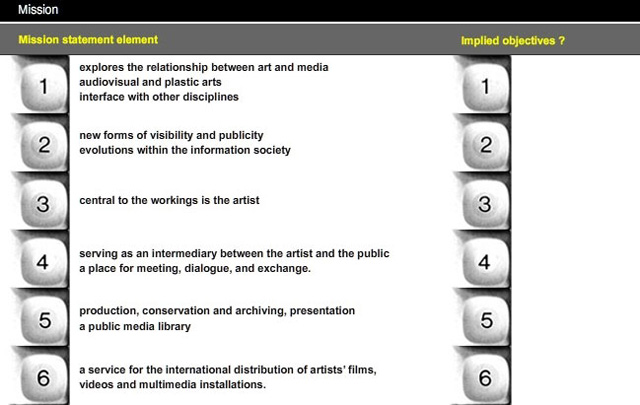Marketing Analysis
Marketing analysis conducted for Argos Centre for Arts and Media by Maxim Surin 2009–2010.
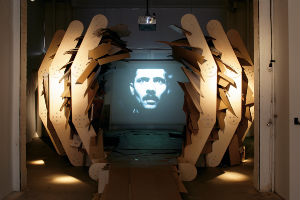
Argos, Centre for Art and Media
History.
Argos was founded in 1989 for the purpose of stimulating and promoting audiovisual art; at present it is the country’s main source of reference for this type of artistic practice.
1989 – 1994
During the first period the organisation focuses on showing a wide variety of works within Belgium. In 1990 Argos sets-up festivals in Antwerp, Brussels and Louvain related to the films and videos realised by Jean-Luc Godard in the 1980s. This is followed in 1991 by ‘Dancing Images’, a festival taking place in those same cities, centring on the relationship between film/video and dance. From 1992 onwards Argos holds a range of thematic programmes in the majority of Belgian arts centres. Apart from organising screenings, Argos also operates as a distributor. Works are thereby distributed to (mainly) foreign festivals, cultural centres, museums and television networks.
1994 – 1996
As hitherto there was no such thing as state funding for the mediating –typically non-commercial tasks, Argos dealt with these itself, soon accruing a deficit. In 1994 the Flemish Community allocates an operational subsidy for the first time, allowing Argos to make a start in decreasing its debts.
1996 – 1999
The realisation of a centre takes shape in 1996, when Argos finds accommodation in the gallery complex at Kanal 20, a Brussels premises situated on the canal, and starts exhibiting video and multimedia installations in its very own space. ‘Eclipse’ by Antwerp artist Anne-Mie van Kerckhoven, is the first presentation, to be followed by projects from Koen Theys, Richard Venlet, Garry Hill, Pascal Baes, Georges Bures Miller, Frank Theys, David Claerbout, and others.
In 1997 the first Argos Information Days are held, with great success, offering an annual preview of Belgian artists’ films and videos. The event continues until 2001, when it is incorporated as the Belgian Focus section within the Argos festival that starts the same year.
Argos moves to the first floor of a former warehouse off Sainctelette Square in 1999.
With a floor area of 500 square metres, of which 300 are solely allocated as exhibition space, Argos is able to operate on a challenging, international and logistically appropriate scale. The space is primarily used for solo exhibitions; in general, projects that are coproduced by Argos. Artists exposing during this beginning period are, amongst others: Jan De Cock, Jayce Salloum, Heinz Emigholz en Joëlle Tuerlinckx.
2000
The video conservation programme starts up. The first project includes more than 100 titles containing an important body of Belgian works from the 1970s. It is the beginning of a conservation effort that, to date, contains more than 2.000 titles. Argos also begins to make its own publications, an activity that over the years results in some twenty catalogues and a number of limited and audiovisual editions.
2001-2002
The first floor space at Argos is renovated.
Architects Kris Kimpe and Bruno Poelaert design a public media library and the Black Box, a separate project space in which video projections and lectures can take place. At the same time a climate controlled archive room is provided. In 2002 French artist Mathieu Mercier realises an integrated art project for the glass door sections of the media library. In the same year, in a separate building situated across from the offices, Argos sets up a workshop where artists can find support facilities.
2001-2005
For five full years the Argos festival offers a platform for various forms of artistic expression within the domain of the audiovisual media. With, on average, ten locations, the festival spans the city. A whole spectrum of activities takes place: exhibitions, film and video presentations, concerts, interventions in the public space, lectures and symposiums. At the end of 2005 it is decided to stop the festival and to spread the programme over the entire year, rather than over ten days. For this reason, an expansion of the premises is planned, along with other improvements.
During the same year, Argos engages in the ‘écran d’art’ (art screen) series, the monthly screening of artists’ film and/or video, jointly organised by Argos and Cinema Arenberg. Also in 2005, Cera becomes a patron of Argos and allocates a subsidy for the subsequent three years, with which to extend the library, and, more particularly, to realise an online presentation of the collection.2006
On the first of January Argos enters into The Arts decree, new subsidy legislation that supports the emancipation of all art disciplines and provides funding covering several years. Argos is recognised as an arts centre. With this comes an end, at the Flemish Community level, of more than ten years of one-year or project subsidies within all kinds of smaller subsidy regulations. At the end of 2006 Argos undertakes a huge rebuilding programme. The ground floor is expanded to achieve an extra 500m², increasing the overall area of exhibition space to over 800m². It is reinstated as a reception and major exhibition/presentation area.
The new ground floor, which is complementary to the existing exhibition space on the first floor, can accommodate large group or solo exhibitions, as well as talks, performances, screenings and musical events.
2007-2008
The expanded public spaces are abundantly filled. Diverse group exhibitions are presented, as well as individual projects. On Thursday evenings there are lectures, concerts and other presentations in the foyer. At the end of 2007 Open Archive takes place, a large-scale event-focused programme that uses the Argos archive as a motive for numerous presentations, lectures, symposiums or performances.
The four-day event, FRONT-end, happening in September 2008, marks the launch of the online media library catalogue.
On 17th September, Argos Center for Art & Media will be launching a brand-new website designed by the Brussels studio Milk & Cookies. This new site is good news for students, researchers, curators and any other interested parties. The arts center’s extensive media library files will be made accessible through an online database system. It is a collection of more than 2000 audiovisual titles going back to the early seventies, plus 3500 publications and numerous catalogues and periodicals. The database itself was developed by the Ghent company Xio.
Argos will be celebrating this opening up of the collection in a number of events spread over four days. The programme includes the Thinking in Loop exhibition and a talk entitled Religion as Medium by the philosopher, essayist and media theorist Boris Groys. As far as films are concerned, there is the premiere of Marie André’s À Alexandre Sergueïevitch. In the Black Box projection room we shall be showing Face to Face, a selection of videos from the Argos collection on the theme of the face. The Brussels record label Sub Rosa will be supplying a healthy dose of musical pleasure with a concert by Charlemagne Palestine, a DJ set by Guy-Marc Hinant and an audio lounge called An Anthology of Noise & Electronic Music 1920-2007.
Present. March 2010
Moving image collection
3600 titles including multi-channel video installations, film, video art, artistic documentaries, performance, festival and lectures registrations. 90 % digitized.
Printed media collection
Books 1915; Book with multimedia 57; Artist`s book 26; Artist`s file 420; Catalogue 587; Catalogue +multimedia 60; Exhibition catalogue 536; Festival catalogue 595; Periodical 68.
Summary 3895 / 15.03.2010 /
Editing and post-production facilities
Offers in-house post-production editing facilities such as digitizing, encoding and print out as well as duplicating video recordings.
Two editing stations are available in our editing studio, which can be worked on individually or with the help of an editor. Artists and art-related institutions can rent the studio on demand. An advance reservation is required.
The following tape formats can be treated: Beta SP (component), Beta digital (component) DV CAM/Mini DV, U-Matic, VHS.
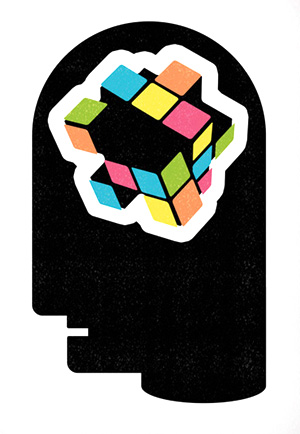
The trigger for Argos Center was crisis, impending financial and cultural meltdown resulting from lack of attention to mission / created several years ago /.
The need to address structural issues, openness for ideas and action, transparency in internal department work flows.
As a result of these crises, Argos started first attempts with organisational development, seeking to deeply understand what the organisation had been delivering against the mission and how its role in the local and national cultural environment had changed.
To understand the value of its connections and the links between its various activities.
To take financial and creative advantage of the opportunities of Argos professional network and capacities of Argos Center.
In the past and present, the organisation has been very demand driven.
Decision taken to make an external analysis of Argos organisational structure and activities.
Analysis was made between October – December 2009 and was presented for Argos team.
Results from SWOT analysis / October – November 2009 /
Participated by directorial board, communication, curatorial, administrative and IT technology department. Totally 7 people.
- Every department shows clear understanding of their problems.
- There must be more transparency between departments.
- Critical character of analysis shows that organization is still alive and ready for positive changes.
SWOT analysis
Classifies the internal aspects of the company as Strengths or Weaknesses and the external situational factors as Opportunities or Threats.
Analysis covered 4 basic artistic activities of Argos :
- Public Activities: exhibitions, event space, film and video screenings, lectures and other related events.
- Archive and Preservation: collections, conservation, database and public Media Library
- Distribution
- Production, facilities
Separating activities is an important issue for this analysis, they are intimately linked within the entire functioning process and overlapping.
Distribution should not be considered as a sub-activity: programmation abroad with work from the own archive.
Exhibitions can often be considered as forms of production in their own right.
Segmentation of activities brings more clear results and help to focus on details.
More broader analysis of operational structure, general policies and communication expected from researcher.
Key topics /for more detailed SWOT go here/:
Public Activities
Visibility.
More transparent internal communication.
Programme diversification and continuation. Co-production.
Clear identity. Communication strategy for different audiences.
Online presence.
Funding.
Archive and preservation
Visibility.
Exploring and evaluating potentials. Collection strategy.
More staff.
New digital archive – new communication tools.
Fluid internal and external presentation, work flow.
National and international presence.
Distribution
Integration within all center activities.
Policy with artists.
Strategical approaches.
Online presentation.
Networking.
Production
Visibility.
Technical potential is not balanced with amount of personnel.
Co-production.
Rental opportunities.
Difficulties of collecting data and absence of any planning or marketing initiatives done before marketing analysis made procedure of marketing analysis complicated.
In order to make all Argos Center activities more efficient, team need to find balance and proportions of input for every aspect and evaluate purpose and goals.
It is important to set the timeline and evaluation scheme.
All Argos activities have more potentials and most of them are known to personnel.
Negative factors are: too small collective for a diverse proliferation of Centre and funding.
Important topics are starting online activity and setting it into the work flow.
Online presentation
In my point of view it is the most unattended side of Argos functionality as internet is the “native” and “default” instrument for digital moving image.
Audiences online could be treated in more efficient way.
Program of Argos Center could be dynamically presented to make meaningful connections and bring the liveliness and sociability of the real to the online experience
Interface!
Strengthen internal communication mechanisms. There must be improvement in using of internal/ external tools for communication.
Folded database, schedule, communication, survey applications, CRM.
At this stage communication plan and strategy development for all activities is a reasonable step.
Argos could improve its working model and evaluate possible scenarios for long – term period.
Digital to digital workflows!

Argos explores the relationship between art and media and how these influence our perception of the world.
In a time when digital information overload, industrial populism and corporate branding set the tone, the arts center devotes itself to new forms of visibility and publicity.
Argos’ territory is comprised of the audiovisual and plastic arts, whereby much attention is given to the interface with other disciplines and to the conscious and alert association with evolutions within the information society.
Central to the workings is the artist, someone who defends critical singularities and confronts us with what is positioned outside of ourselves.
Serving as an intermediary between the artist and the public, Argos strives to be a place for meeting, dialogue, and exchange.
Its functions include production, conservation and archiving, as well as presentation – exhibitions, film and video showings, lectures and performances;
additionally, Argos houses a public media library and provides a service for the international distribution of artists’ films, videos and multimedia installations.
Articulation of the mission.
- the identification of new opportunities for cross-sector collaboration and the creation of sustainable collaborations between arts, media and technology partners.
- project management
- research, knowledge exchange and networking activities.
Developing co-production projects, possibly enticing investment from individuals and companies and establishing a creative micro-investment fund to provide small development
grants and a programmes of support starting exploration of creative, cultural or technological innovation.
It is important to understand how mission differentiate activities and necessitate their forms.
Mission statement elements:
- explores the relationship between art and media audiovisual and plastic arts interface with other disciplines
- new forms of visibility and publicity evolutions within the information society
- central to the workings is the artist
- serving as an intermediary between the artist and the public a place for meeting, dialogue, and exchange.
- production, conservation and archiving, presentation; a public media library
- a service for the international distribution of artists’ films, videos and multimedia installations.
Implied objectives?
Next set of questions are focused on future visions, identity and policies. Documented from the Argos staff meeting in October 2009.
1
Enormous fields. Constantly changing, in flux. Both rooted in history/ experience as in evolutions/ experiment.
Balancing in between the content and package of it. Constant learning positions and critical attitude.
Active role in its home city, collaborations. Dare to take political stance.
2
An open, democratic platform – both in “reality” as a virtual hub – of knowledge. Motor for critical reflection. Place that sets an example.
Meeting point of references and expertise in the field. On the crossroads of disciplines, visions and cultures.
A turning point for exchange between artists and sector, inclusive and exclusive parties.
Continuously changing network, rooted in the local, national and international scenes.
Reacts on fast developments in the area of information and technology. Shows, researches and experiments, scans this ensemble in a range of actions.
Reacts on changing social structures, attains and engages different groups of public. Shows a clear engagement towards society through all the actions.
3
Turn completely into facilities provider/ platform / give value to studio and knowledge. Network for people who use our tools/ facilities.
Residency. Involve schools, collaborative projects within event frame.
Touring of exhibitions requires networking and flexibility.
Go public or give space to curators from outside.
Continuous reflection on what we are and what we do, our tasks through activities.
4
Communication plan is urgently needed.
More social events take place and affective relations with artists stressed.
Missing “exchange” and “meeting” point.
5
Digital content delivery.
What are we? Where is Argos going?
What do we want to do now and what position would like to have?
Strategic Framework. Implementation timeline. Evaluation
- Developing clear practical vision for the next 5-10 years.
- Identifies what will actually be done over the next 12 months to move things forward and who will do it.
Practical signs of success
- Argos’s mission is clearly articulated
- Mission can be easily and enthusiastically conveyed to new stakeholders
Strategy

translates the promotional aims and objectives of your institution into a framework that summarizes, as a minimum:
- Your target fields
- The objectives for each field / share, growth, improved margins, better quality students or staff, increased donation value, etc. /
- The basis upon which you will compete / positioning) in each field (fees, convenience, reputation, relevance, innovation, etc. /
- The range of core and support services to be offered
- How growth / in terms of volume or financial margins, for example / is to be achieved
- penetrating core fields or developing new ones
- Critical success factors or potential barriers
Strategy should be built on:
- Your mission, vision and values – what is the purpose of the Argos Center and where does it want to be in X years time?
- Financial analysis – what services and fields make money and which consume it?
- Reputation and image assessment
- A relative SWOT analysis
- Competitor evaluation
- Field needs/demand analysis and forecasting
- Understanding “consumer behavior” – how choices are made
- Marketing evaluation (resources, competencies, integration, etc.)
- Feedback from current and recent visitors, members, artists, students, clients.
Collaborator/ co-production appraisal.
Compiling a strategic co-production and collaborator group appraisal according to their strategic groups.
Organisation – Basis/ reasons for being collaborators, or likely approach to collaborations.
Model
“In the digital media industry the only way to stay competitive is to use the emergent technologies before others adopt them. It’s the pioneers, early adopters and risk-takers that succeed.”
John Manley, HP Labs Bristol in Under Blue Skies: the Watershed/HP Labs partnership (2005)
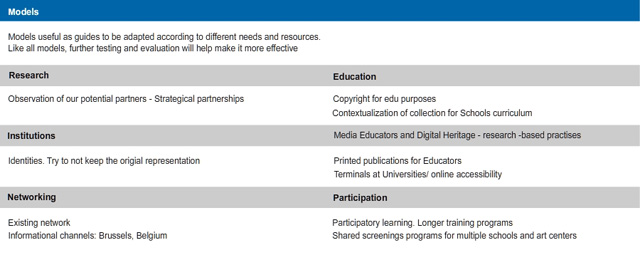
Argos activities need to result in new skills and capacity, more challenging creative practice, bringing benefit to a network of academic, commercial and cultural partners working within the Creative Economy.
Access to a broader knowledge and ideas base will result in higher quality research outcomes, artists and multimedia producers will get access to technologies and distribution venues, enabling them to develop their creative practice and industry partners will benefit through the real-world testing of new technologies,resulting in creative solutions to technological Research and Development problems.
Once the strategy is in place the next level is a plan, which typically focuses on a field or a cluster of activities.
Writing an institutional marketing plan can be a long process, complicated by the competing factors within an institution.
A plan without research is useless; each element of the plan has to be based on some element of Argos Center background work.
Structuring the plan is very important.
Setting your objectives, methods, research and analysis, implementation and review processes in as clear fashion as possible will make the marketing plan more useful.
Define fields markets as specifically as possible and relate these to your communications tools and methods.
Set of planning outlines for technological/ editorial aspects of Argos Centre and online Platform.
Maxim Surin June 2010.
Repository
Full technical description/ analysis of actual database and make decisions on how to split it.
Further keep only cultural content: works, books, artists and related materials in repository.
Integration
Explore ways to connect postgreSQL and mySQL, actual database and WordPress front-end /PostgreSQL plugin for WordPress /PG4WP/.
Webcode of actual site to remap it for new WordPress front-end.
Possibilities to integrate Argos internal Google Calendar as Agenda on all sites.
Contact & contracts management applications
Extract contacts and bookkeeping data into professional CRM or/ and contact management system with project management functionality / tested Tactile CRM /.
Examples of similar online applications: http://www.activecollab.com, http://goplanapp.com, http://www.myclientspot.com, aceproject.com, http://www.veoproject.com, http://www.easyprojects.net , http://www.arquila.com
Front end
Argos Platform for Media and Arts. Installation of WordPress 3.0 multiuser for building the architecture/ structure of Platform: Public Activities site, Distribution site, Collections site, Research site, Argos Labs site and Open Archive #2 site.
Choose Premium WordPress themes.
1st priority is all static pages on platform in three languages. Static pages navigation and categories.
Publishing
Internal workflow with front – end: Training and awareness raising for staff – explain how publishing works – adjust the structures of content flow between Public activities site, Distribution site, Collections site, Research and Labs sites.
Roles and responsibilities within the organisation.
Decision Tree and Editorial aspects.
Metadata
Types of electronic publications which need to be captured by archival system.
Decisions on customizing types of digital publications/ records: book, event, video, documentation, review, interview, exhibition, screening / examples /.
What metadata needs to be kept with digital publications/ records?
Definition of records which constitute permanent publication worthy of long-term preservation.
What naming conventions should be used?
Status of electronic records within the organisation and broad definitions of what they constitute.
Unique identifiers.
Permanent locations
Permalinks for files on server and link resolving schemes. Sub-directories or sub-domains.
Collections description
and priorities lists to be published first and researched.
Collection management tools
Collective Access / Collection tool /. Organize and annotate all repository content.
Mapping tools for batching old database / sample/ re-mapping codes available on demand/. EYE Dutch Film Institute will share their implementation version on CA / Planned to be ready by late autumn 2010 /.
External support. Andrew McKenzie. September 2010. Developer visit from Collective Access to complete implementation. Schedule.
Kaltura video publishing and management platform.
Implementation of Kaltura video publishing and management services.
September 2010. Be able to generate CSV file for batching the database metadata into Kaltura services.
Decision on how many titles/ works we will use for Kaltura video publishing and management service: average overall size of this works.
Decision on format for uploading – it is really affects the price of services. Size = cost of Kaltura service package.
Services includes hosting on their servers and 24 support.
Mobile delivery, syndication packages included. Basic package starts from 500 dollars a month for 300 Gb of content uploaded to Kaltura servers.
Prepare videos / clean beginnings and ends and encode /. Inserting metadata and copyright with Frameline 47 / Dublin Core base /.
Like all other plans, a marketing plan establishes what you want to do, who will do it, how it will be done, when it will be done and how its impact will be measured.
“This we’ll do!”
“We see the urgency and foremost the importance of the project, but in order to make it work it will have to be:
- a collaborative project within Argos Centre with Maxim Surin in charge of decisions (not more than logic since it is your work domain).
- a written work package (what actions, what logistic/financial needs and implications, by whom (what expertise we address outside + from whom we can benefit within the organisation?
- fixed progress meetings
- most rewarding / and it will help to re-address the situation /: start doing…
- design an as complete as possible skeleton of the platform site and it’s features,
- contact expertise outside Argos for mapping and to acquire feedback on metadata-issues and exchange possiblities with other institions…”
Paul Willemsen. Argos Center Artistic Director.
Transition plan accepted 12 of July 2010.
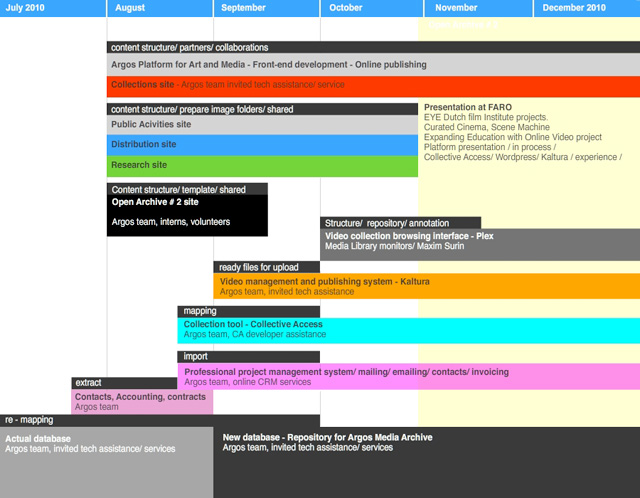
Proposal
This call for proposals was launched for Belgian educational sector. Subjects offered in the fields of media and communication technologies /MCT/:
Video archival development – Analysis of multimedia contents – Standards for graphics transmission – Content Management Systems – Distributed databases – Data visualisation – Technologies of Semantic Web – Web 2.0 technologies
Video archival development. Actual technologies for digitizing, restoring, preserving and archiving time-based media, “old” and digitally born.
Analysis of multimedia contents. Content annotation. Multimedia contents must be analyzed separating the sources (audio, video, still images, text) and combining in a more semantic way the low and high level analysis of each type of content, provides a more automatic method to manage and retrieve contents.
Standards for graphics transmission. /codecs MPEG-2,MPEG-4,metadata container MPEG-7/MXF/
Knowledge and application of different standards for the transmission of audiovisual information and multimedia, valid for multiple platforms and devices.
Metadata, tagging/ Methods and technologies.
Content Management Systems /CMS/ Current research WordPress 3.0. Tools for digital content management during the whole life-cycle, from the creation to the publishing and dissemination. These systems will include data acquisition and storage systems, and rights management systems.
Distributed databases. Interface. Advanced techniques of interaction and graphical interface, including aspects of accessibility, usability, graphical representation, interaction modes and different platforms.
Data visualization. How do designers structure complex data? Where do we find the information that we are looking for? What is the most effective way nowadays to communicate a work of art?
Technologies of Semantic Web. Application of the Semantic Web technologies to the information processing and knowledge management, focused on graphic environments of knowledge transmission.
Web 3.0 technologies. New ways of generating, managing and using user-generated contents, analyzing emerging applications such as real-time syndication portals or semantic annotation.
Reports excerpts:
CATCH Continuous Access To Cultural Heritage
Symposium Report. Amsterdam 2010
Cultural heritage is everywhere, and constitutes our collective memory.
CATCH develops generic methods and techniques cutting across the areas of the humanities and computer science, aiming to facilitate an interaction with cultural heritage institutions. Innovation, multidisciplinary collaboration and transferability are essential.
/watch presentation here /
Theme of the day:
“Digital Cultural Heritage Goes Social”
We are now witnessing new paradigms for engaging users with our shared heritage. The new paradigms imply, in many cases, the need for profound change in institutional practice.
For instance, using the power of the Social Web to enrich the knowledge about our shared heritage. During the CATCH day we want to put the possible interaction between the Social Web and cultural heritage into the limelight by presentations and discussions on this theme.
Marijke Oosterbroek – Story of success / Amsterdam Historische Museum
10 outlines:
Learn by doing – Experiment – Do it yourself – Quality is not a goal in itself – Keep it simple – Dare to fail – Cooperate – Share experience – Copy success – Be honest
Nobody can disagree with this goals…
This way is quick in compare with high quality which is always late. Publish material the way it is.
Shared: 25 000 hi-res photos to use for community website. *sharing with social network is always cheap
Courage.
To follow and get result on the long run. Challenge more people with more diverse backgrounds.
Main practices:
Sharing – Participation – Cooperation – Communication – Co-creation – Equality – Agility
Small museum collective is working with WordPress, Twitter, Hyves by themselves. Idea is to use all functionalities to have meaningful conversation with audiences.
Museum blog 40 000 active members. Corporate site is still in use to guide to all different platforms and social networks.
Just doing things
“Database is shared for partners so they can use it for reference. Universities for free.”
Prototyping Smithsonian Commons
Carmen Iannacone – Chief Technology Officer for the Smithsonian Institution.
Responsible for evaluating and implementing new technologies for use in the Smithsonian IT infrastructure, and for optimizing performance of its IT operations.
The Institution’s nineteen museums and research stations provide a diverse technology climate, and his role is an integral liaison between centralized IT and the public.
Prior to joining the Smithsonian, Carmen Iannacone served as director of worldwide IT operations for the Federal Acquisition Service of the General Services Administration (GSA), and was partner a software development consultancy in Alexandria, VA. He holds several patents for software and lives in Sterling, VA.
More information about Smithsonian Institution
Quick facts: 19 museums, 19 countries, 37 000 000 items, 6 000 employees
Prototype:
The strategy talks about an updated digital experience, a new learning model that helps people with their “lifelong learning journeys”
Strategic plan is divided into tactical projects.
Goals:
Empowering citizens – scholars
- Blend assets with new technologies
- Foster interdisciplinary collaborations and partnerships
Innovative informal education. It is unique times to do something with institution. Relevance earned through a job well done.
Do not accumulate knowledge within the walls, but send it out to the world. Public inclusive approach – Outreach.
Shared tools, services and standards. Balancing autonomy – Working in close proximity.
Commons
Set of resources maintained in the public sphere.
Open Access
Efficient and scalable knowledge / creation platform. DRAFT! Nothing official!
4 user stories:
- Museum visitor
- 4th grade teacher
- Millennial /generations born in a new century /
- Enthusiast / Citizen Scientist
Supply an instruments to attach found things to commons.



